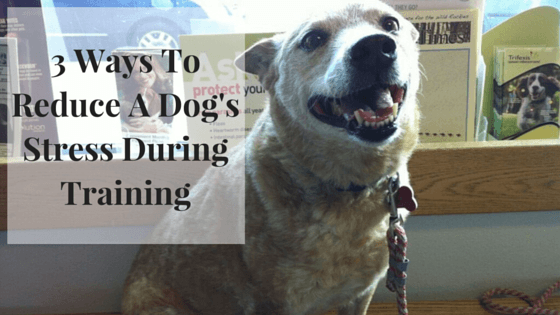
Reducing Stress In Dog Training
The very nature of training can be stressful to a dog. Not all stress is bad. However, when a dog has many different stress-inducing factors piled on top of each other, this can become overwhelming and cause the dog to act out or shut down. When a dog is too stressed out, learning does not occur. For this very reason, we must try to minimize the amounts of environmental stress our dogs experience during training. Here are three ways you can reduce stress in dog training.
1. Clean Clicker Mechanics
If a teacher were asking you questions in class and then having to look up every answer you gave them to make sure they were right, you’d become incredibly frustrated after a while. The same thing can happen with our dogs. If our marker words or clicks are too slow, our treat delivery sloppy, or our attention is not completely on our training session, the dog is likely to get frustrated and may stop trying. Making sure your mechanics are clean and on time will do a lot for a dog’s confidence and stress level. It’s also our job, as the trainer, to make sure our client’s mechanics are clean. Playing some clicker mechanic games before introducing your client’s newly acquired training skills to their dog can go a long way for the stress level of their dog. You can find more about clicker mechanics here.
2. Appropriate Distraction Levels
When a dog is worked in an area where there are too many distractions for their level of training, they can become incredibly stressed for a few different reasons. If the dog is prone to being anxious, too many distractions can cause them to go through information overload and they can become stressed out. When a dog is stressed, they cannot provide their owners with the attention their owners want. When the owners see their dog’s attention elsewhere, the owner can become stressed with the training process. Feeding off the owner, the dog becomes even more stressed. It is a stressful cycle to get in. To make both the dog and owner successful, lowering the distractions around the session to a level the dog can be successful is key.
3. Small Steps
When we are working with clients and their dogs, we are generally helping them build behaviors for their dogs. We have to take small steps towards the big picture goal. When we expect dogs to take leaps in training, they can become lost and get stressed when they don’t know what we are asking for. Training will go quicker when we ask for smaller steps that they can build on quickly. Taking larger steps may slow us down as the dog has to guess and interpret what we are asking for.
Some level of frustration will always be present in training, however, we should always do our best to make sure the least amount of frustration is present when training. Showing our clients how to use a clicker and how to build behaviors appropriately is our duty as a trainer. When our dogs are happy, we will get cleaner, quicker, and better behaviors.
What other ways can we lower our dog’s stress during a training session?
Get Dog Training Business Tips!
Receive valuable dog training business tips and resources every week! Subscribe to The Modern Dog Trainer now by submitting your name and email below.
[mc4wp_form]



